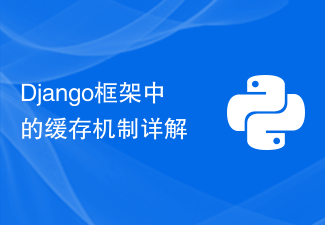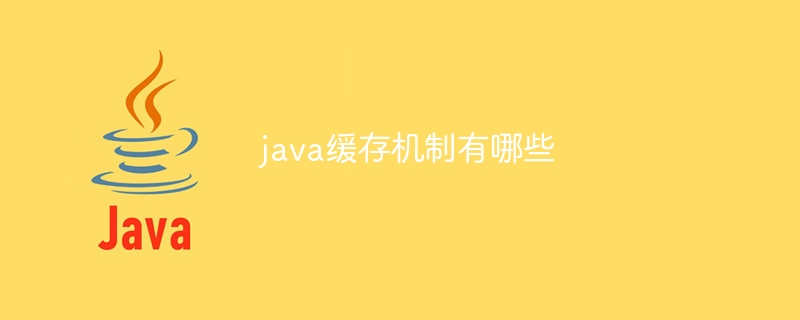Mainly includes data cache, file cache, page cache, cache update, etc. Detailed introduction: 1. Data caching: Mini programs can store data locally so that they can be directly read and updated when needed, without the need to obtain it from the server every time. This caching method can reduce the burden on the server and improve the performance and response speed of the mini program; 2. File caching: the mini program can save some commonly used files or resources locally, such as pictures, videos, audios, etc., to reduce the impact on the server. and network access times, improve the response speed and user experience of the mini program, etc.

Operating system for this tutorial: Windows 10 system, Dell G3 computer.
The caching mechanisms of mini programs mainly include the following:
- Data caching: mini programs can store data locally so that they can be directly read and updated when needed. Instead of getting it from the server every time. This caching method can reduce the burden on the server and improve the performance and response speed of the mini program.
- File caching: The mini program can save some commonly used files or resources locally, such as pictures, videos, audios, etc., to reduce the number of visits to the server and network and improve the response speed and user experience of the mini program. .
- Page caching: The applet can save the page content locally so that the page content can be directly rendered the next time you visit without reloading the page. This caching method can improve the response speed and user experience of the mini program.
- Cache update: The applet can regularly update the data and files in the cache to ensure the latestness and accuracy of the cached data. At the same time, the applet also needs to handle cache update conflicts and synchronization issues to ensure data consistency between multiple devices or users.
In the caching mechanism of the mini program, you need to pay attention to the following points:
- Cache strategy: The mini program needs to choose an appropriate caching strategy based on actual needs and business scenarios. For example, comprehensive considerations should be made based on factors such as data type, access frequency, and data size.
- Cache invalidation: In order to ensure the correctness and integrity of the data, the mini program needs to regularly clear expired or invalid cache data and update the data in the cache in a timely manner.
- Cache capacity: Mini programs need to reasonably control the cache capacity to avoid taking up too many memory resources due to excessive cache capacity, resulting in reduced performance of the mini program.
- Cache security: Mini programs need to take some security measures to protect the security and privacy of cached data, such as encrypted storage, access control, etc.
The above is the detailed content of What are the mini program caching mechanisms?. For more information, please follow other related articles on the PHP Chinese website!
 Golang中实现高效电商推荐算法的缓存机制。Jun 20, 2023 pm 08:33 PM
Golang中实现高效电商推荐算法的缓存机制。Jun 20, 2023 pm 08:33 PM随着电商业务的蓬勃发展,推荐算法成为了各大电商平台竞争的关键之一。作为一门高效、高性能语言,Golang在实现电商推荐算法方面有着很大的优势。但是,在实现高效推荐算法的同时,缓存机制也是一个不可忽视的问题。本文将介绍如何在Golang中实现高效电商推荐算法的缓存机制。一、为什么需要缓存机制在电商推荐算法中,推荐结果的生成需要耗费大量的计算资源,对于高并发的电
 Django框架中的缓存机制详解Jun 18, 2023 pm 01:14 PM
Django框架中的缓存机制详解Jun 18, 2023 pm 01:14 PM在Web应用程序中,缓存通常是用来优化性能的重要手段。Django作为一款著名的Web框架,自然也提供了完善的缓存机制来帮助开发者进一步提高应用程序的性能。本文将对Django框架中的缓存机制进行详解,包括缓存的使用场景、建议的缓存策略、缓存的实现方式和使用方法等方面。希望对Django开发者或对缓存机制感兴趣的读者有所帮助。一、缓存的使用场景缓存的使用场景
 java缓存机制有哪些Nov 16, 2023 am 11:21 AM
java缓存机制有哪些Nov 16, 2023 am 11:21 AMjava缓存机制有内存缓存、数据结构缓存、缓存框架、分布式缓存、缓存策略、缓存同步、缓存失效机制以及压缩和编码等。详细介绍:1、内存缓存,Java的内存管理机制会自动缓存经常使用的对象,以减少内存分配和垃圾回收的开销;2、数据结构缓存,Java内置的数据结构,如HashMap、LinkedList、HashSet等,具有高效的缓存机制,这些数据结构使用内部哈希表来存储元素等等。
 阿里云缓存机制有哪些Nov 15, 2023 am 11:22 AM
阿里云缓存机制有哪些Nov 15, 2023 am 11:22 AM阿里云缓存机制有阿里云Redis、阿里云Memcache、分布式缓存服务DSC、阿里云Table Store、CDN等。详细介绍:1、阿里云Redis:阿里云提供的分布式内存数据库,支持高速读写和数据持久化。通过将数据存储在内存中,可以提供低延迟的数据访问和高并发的处理能力;2、阿里云Memcache:阿里云提供的高速缓存系统等等。
 浏览器缓存机制有哪些Nov 15, 2023 pm 03:25 PM
浏览器缓存机制有哪些Nov 15, 2023 pm 03:25 PM浏览器缓存机制有强缓存、协商缓存、Service Worker和IndexedDB等。详细介绍:1、强缓存,浏览器在请求资源时,会先检查本地缓存是否存在该资源的副本,并且该副本是否过期,如果资源的副本未过期,浏览器就直接使用本地缓存,不会向服务器发送请求,从而加快了网页加载速度;2、协商缓存,当资源的副本过期或者浏览器的缓存被清除时,浏览器会向服务器发送请求等等。
 Golang中实现高效在线广告投放算法的缓存机制。Jun 21, 2023 am 08:42 AM
Golang中实现高效在线广告投放算法的缓存机制。Jun 21, 2023 am 08:42 AMGolang作为一门高效的编程语言,近年来受到越来越多开发者的欢迎,并在各种场景下被广泛应用。在广告平台场景中,为了实现精准的广告投放,需要对广告的选择、排序、过滤等流程进行快速的计算,以达到高效的广告投放目的。而为了优化这个流程,缓存机制成为了不可避免的一部分。一般而言,广告平台的流程大概如下:当用户在浏览网页时,广告平台通过各种方式收集到用户的信息,并通
 html缓存机制有哪些Nov 15, 2023 pm 05:58 PM
html缓存机制有哪些Nov 15, 2023 pm 05:58 PMhtml缓存机制有浏览器缓存、缓存HTTP头、Expires、ETag、Last-Modified等。详细介绍:1、浏览器缓存,是一种基于浏览器的缓存机制,它将之前访问过的网页内容存储在用户的计算机上,以便在下次访问时能够更快地加载和显示网页内容;2、缓存HTTP头,是HTTP/1.1规范中的一种缓存机制,它通过设置响应头来控制浏览器对资源的缓存行为;3、Expires等等。
 http缓存机制有哪些Nov 16, 2023 am 10:48 AM
http缓存机制有哪些Nov 16, 2023 am 10:48 AMhttp缓存机制有缓存头、缓存策略、缓存命中、缓存失效、缓存回收、缓存一致性、缓存替换策略、代理缓存、浏览器缓存、压缩和编码、CDN缓存等。详细介绍:1、缓存头,是HTTP请求和响应中包含的元数据,用于控制缓存的行为;2、缓存策略,Web服务器使用缓存策略来确定如何处理缓存请求;3、缓存命中,当浏览器再次请求相同的资源时,如果该资源已经在缓存中可用,则浏览器会直接从缓存中等等。

Hot AI Tools

Undresser.AI Undress
AI-powered app for creating realistic nude photos

AI Clothes Remover
Online AI tool for removing clothes from photos.

Undress AI Tool
Undress images for free

Clothoff.io
AI clothes remover

AI Hentai Generator
Generate AI Hentai for free.

Hot Article

Hot Tools

Dreamweaver CS6
Visual web development tools

DVWA
Damn Vulnerable Web App (DVWA) is a PHP/MySQL web application that is very vulnerable. Its main goals are to be an aid for security professionals to test their skills and tools in a legal environment, to help web developers better understand the process of securing web applications, and to help teachers/students teach/learn in a classroom environment Web application security. The goal of DVWA is to practice some of the most common web vulnerabilities through a simple and straightforward interface, with varying degrees of difficulty. Please note that this software

WebStorm Mac version
Useful JavaScript development tools

Atom editor mac version download
The most popular open source editor

MinGW - Minimalist GNU for Windows
This project is in the process of being migrated to osdn.net/projects/mingw, you can continue to follow us there. MinGW: A native Windows port of the GNU Compiler Collection (GCC), freely distributable import libraries and header files for building native Windows applications; includes extensions to the MSVC runtime to support C99 functionality. All MinGW software can run on 64-bit Windows platforms.






